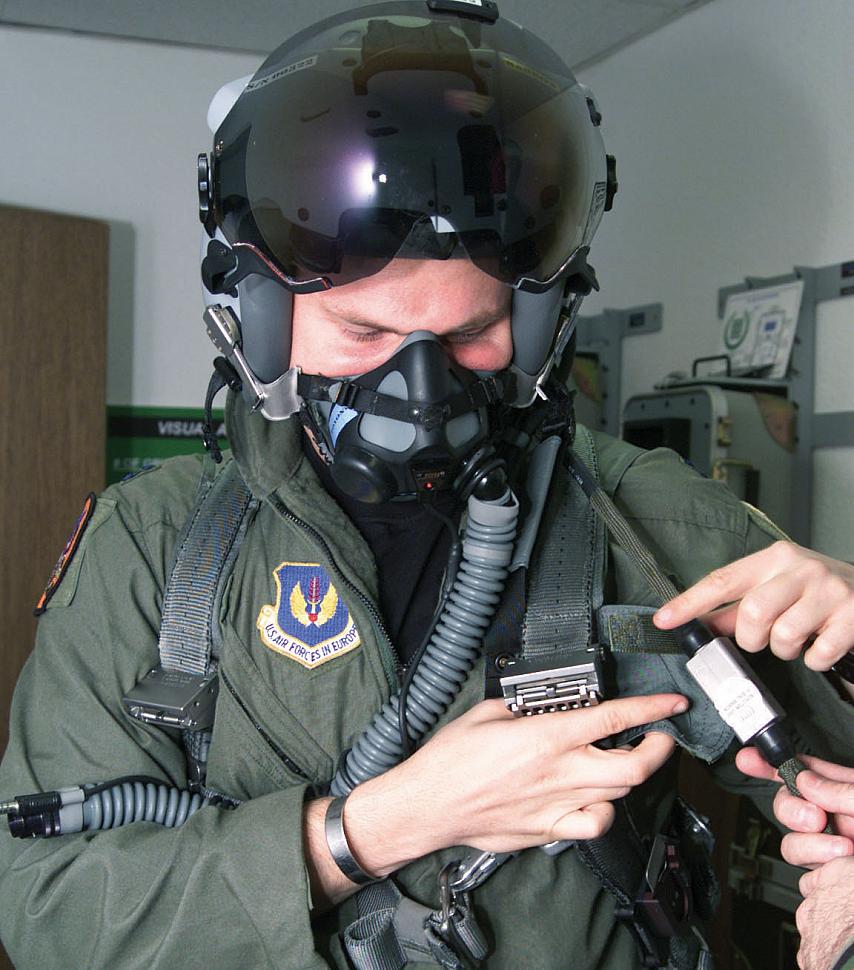Fighter Jet News
F-16 Fighting Falcon News
Joint Helmet-Mounted Cueing System enhance F-16 air power
October 14, 2004 (by
Senior Airman Amaani Lyle) -
Because split seconds can mean the difference between life or death for a pilot in combat, the 52nd Fighter Wing based adopted an advanced approach to high-tech man-machine interaction with the Joint Helmet-Mounted Cueing System.

F-16 Fighting Falcon pilots based at Spangdahlem Air Base, Germany, can now look, lock and launch on an enemy target in the blink of an eye.
The system provides an electronic interface allowing the helmet and jet to communicate putting critical data less than three inches from a pilot's right eye.
Human retinal nerve impulses and eye movement can be faster than one-twenty-fifth of a second. Pilots quickly locate, track, identify and lock onto airborne and ground-based targets at longer ranges and safer altitudes -- all by simply looking at a target, said Staff Sgt. Terence Zelek, a life-support technician with the 23rd Fighter Squadron.
"By keeping their eyes pointed outside the cockpit, pilots will be better equipped to support the formation via visual lookout and avoid potential midair collisions in crowded airspace," said Lt. Col. David Youtsey, 52nd Operations Support Squadron director of operations.
Avoiding such collisions is part of what makes the nearly $100,000 price tag per system money well spent, Colonel Youtsey said.
"Compared to the cost of a trained pilot, the cost of the (F-16), or the cost of many weapons that are used only once, the price is not an issue," he said. "(With) more survivable air attack engagements or faster destruction of enemy ground forces during a close-air support mission, the benefits are easily recognized."
Colonel Youtsey said the new system also pays dividends in training.
"Our young pilots will learn the skills and tactics necessary to transfer to more capable aircraft," he said. "The skills acquired via (the system) will support the fielding decisions and employment tactics of those future stealthy platforms in an even more networked and sensor-dense battle space."
One pilot said the ease of the helmet system makes the idea of returning to the "old-fashioned" system unappealing, but he also recognizes the importance of meticulous training, fitting and assembly on the new system.
"Your head is connected to the end (of the cord) and inside the helmet," said Capt. Kevin Lord, 23rd FS life-support officer and F-16 pilot. During an ejection or other mishap, "if the (system) is improperly connected, it could rip your head off."
Three dedicated rides with an instructor, coupled with a regular flight schedule, should keep pilots proficient with the new equipment.
"When you know how to wear (the helmet) and it's properly fitted, it's awesome," Captain Lord said. "It's first look, first lock, first kill and now we can track altitude, speed and just about any information we need to keep the aircraft level and in our control."

Capt. Kevin Lord demonstrates the Joint Helmet-Mounted Cueing System that is now used in the 52nd Fighter Wing's F-16 Fighting Falcons at Spangdahlem Air Base, Germany. The new system puts critical data less than three inches from a pilot's right eye. Captain Lord is an F-16 pilot with the 23rd Fighter Squadron. [U.S. Air Force photo by Senior Airman Amaani Lyle]
The system provides an electronic interface allowing the helmet and jet to communicate putting critical data less than three inches from a pilot's right eye.
Human retinal nerve impulses and eye movement can be faster than one-twenty-fifth of a second. Pilots quickly locate, track, identify and lock onto airborne and ground-based targets at longer ranges and safer altitudes -- all by simply looking at a target, said Staff Sgt. Terence Zelek, a life-support technician with the 23rd Fighter Squadron.
"By keeping their eyes pointed outside the cockpit, pilots will be better equipped to support the formation via visual lookout and avoid potential midair collisions in crowded airspace," said Lt. Col. David Youtsey, 52nd Operations Support Squadron director of operations.
Avoiding such collisions is part of what makes the nearly $100,000 price tag per system money well spent, Colonel Youtsey said.
"Compared to the cost of a trained pilot, the cost of the (F-16), or the cost of many weapons that are used only once, the price is not an issue," he said. "(With) more survivable air attack engagements or faster destruction of enemy ground forces during a close-air support mission, the benefits are easily recognized."
Colonel Youtsey said the new system also pays dividends in training.
"Our young pilots will learn the skills and tactics necessary to transfer to more capable aircraft," he said. "The skills acquired via (the system) will support the fielding decisions and employment tactics of those future stealthy platforms in an even more networked and sensor-dense battle space."
One pilot said the ease of the helmet system makes the idea of returning to the "old-fashioned" system unappealing, but he also recognizes the importance of meticulous training, fitting and assembly on the new system.
"Your head is connected to the end (of the cord) and inside the helmet," said Capt. Kevin Lord, 23rd FS life-support officer and F-16 pilot. During an ejection or other mishap, "if the (system) is improperly connected, it could rip your head off."
Three dedicated rides with an instructor, coupled with a regular flight schedule, should keep pilots proficient with the new equipment.
"When you know how to wear (the helmet) and it's properly fitted, it's awesome," Captain Lord said. "It's first look, first lock, first kill and now we can track altitude, speed and just about any information we need to keep the aircraft level and in our control."
Courtesy of 52nd Fighter Wing Public Affairs Office
Related articles:
Forum discussion:
Tags
Forum discussion:
Tags
